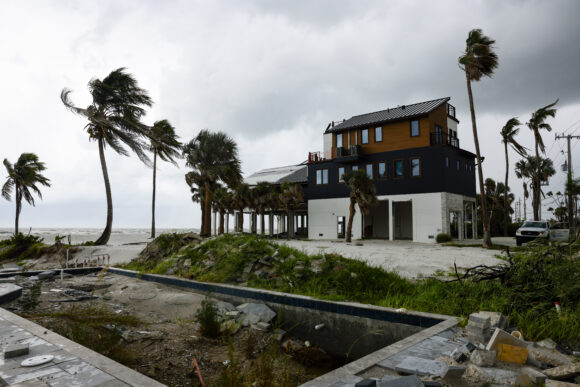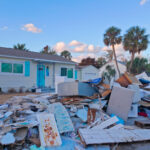This has been a year of insurance sticker shock in the US. But the man who provides insurance to insurers thinks maybe the shock still isn’t enough to steer people away from risk in a changing climate.
“There is not a lot of action yet, not enough,” Jacques de Vaucleroy, chairman of Swiss Re, said in a recent interview at the company’s Manhattan offices. Homes are still being built in places they shouldn’t be, he noted, and often grandly at that. Premiums relative to the potential payout for a claim are still acceptable for many consumers, he added.
Such a view might infuriate homeowners in Florida, where the average premium has topped $5,000 and where more than 1 million residents have turned to the state-backed insurer of last resort because they can’t find or afford a policy on the private market. But reinsurers like Swiss Re have a more global view.
So perhaps it’s understandable that de Vaucleroy believes more expensive insurance will have beneficial effects. “My hope is that when it starts to bite, we will see that the traditional responses are not working,” he said. “Then there will be way more money, way more interest” in steps to mitigate and adapt to climate impacts, and even in informed retreat from risky areas.
Getting granular information on US home insurance costs is difficult because insurers have fought efforts to systematically collect Zip-code-level data on premiums. However, researchers Benjamin Keys and Philip Mulder recently tried a new approach of gathering data through mortgage escrow payment servicers. In a National Bureau of Economic Research working paper published this month, they write that average nominal home insurance premiums across the US increased by 33% between 2020 and 2023, from $1,902 to $2,530. That represents a 13% real increase.
Their paper also puts a clear price on local catastrophe risk, finding that “one standard deviation increase in disaster risk is associated with an average annual premium increase of $335.”
But the most relevant finding might be who is to blame for soaring insurance costs. Among many factors, including inflation and higher home values, the cost of reinsurance for insurers is the biggest culprit. Prices for US property catastrophe reinsurance doubled between 2018 and 2023, Keys and Mulder write, in part because reinsurers had a “climate epiphany” and realized the need to reprice risk. That explains “nearly two-thirds of the increase in the pass-through of risk to premiums,” they note.
Not surprisingly, de Vaucleroy was quick to push back on that, saying inflation and big, high-value houses are still very much factors. But he does see a world where risk is rising and reinsurance has gotten the religion of pricing it. He’d like to see others follow.
“In France, there are areas where over the last two years it flooded five times,” he said, yet “it is still possible to build a new house there.” He said there is “blame” for people still willing to keep building, but also for authorities who allow it.
The NBER paper estimates that the 5% of US households that are most climate-exposed will see insurance rates rise at least $700 by 2053. De Vaucleroy wouldn’t put a number on it, but he agreed prices will continue their upward trend.
The “optimistic” scenario, he said, is that the higher prices force changes that make everyone more prepared for risk. He offered as a parable a past reckoning within the insurance industry. When a strong market demand arose for cybersecurity insurance, insurers initially couldn’t meet it because they didn’t understand the risks. This forced companies to get a better grip on the security of their own systems, including by training all personnel to be alert and putting more cyberthreat experts on staff.
Similarly, people and public officials have to start modifying their behavior as climate impacts mount. “There is still not a lot of positive action, there is mostly reaction,” said de Vaucleroy, but as costs go up, “public policy will evolve. There will be adaptation measures, mitigation, avoidance and so on. We need that to come into place.”
Photo: A damaged pool next to a hurricane-resistant home following Hurricane Ian in Fort Myers Beach, Florida, in 2023. Photographer: Eva Marie Uzcategui/Bloomberg
Topics USA Homeowners Climate Change
Was this article valuable?
Here are more articles you may enjoy.



 Florida Bill Advances, Would End Board of Engineers, Other Professional Agencies
Florida Bill Advances, Would End Board of Engineers, Other Professional Agencies  USI Says Lockton, Former Team Leader Poached Workers, Harmed Client Relations
USI Says Lockton, Former Team Leader Poached Workers, Harmed Client Relations  More Floridians Moving Out Due to Housing, Insurance Costs, Cotality Report Says
More Floridians Moving Out Due to Housing, Insurance Costs, Cotality Report Says  Global Q1 Commercial Insurance Rates Drop 3%, but US Casualty Bucks the Trend
Global Q1 Commercial Insurance Rates Drop 3%, but US Casualty Bucks the Trend 

